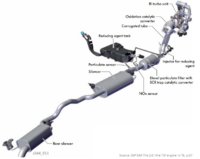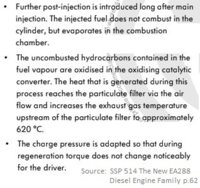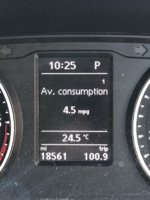You are using an out of date browser. It may not display this or other websites correctly.
You should upgrade or use an alternative browser.
You should upgrade or use an alternative browser.
I would say yes - there is a significant risk.
I have observed that during regen temperature at DPF inlet is typically about 650C and of course almost the same at DPF outlet. When vehicle was stopped during active regen, the temperatures on tick over were still above 500C for more than a minute and seems to stay like that if the engine needs to keep on active regenning. I haven't measured surface temperatures but I'm afraid they are almost as hot as the exhaust gases (as above). The measurements were done in March at outside temp 0C. EU6 150PS engine.

I have observed that during regen temperature at DPF inlet is typically about 650C and of course almost the same at DPF outlet. When vehicle was stopped during active regen, the temperatures on tick over were still above 500C for more than a minute and seems to stay like that if the engine needs to keep on active regenning. I haven't measured surface temperatures but I'm afraid they are almost as hot as the exhaust gases (as above). The measurements were done in March at outside temp 0C. EU6 150PS engine.

I would say yes - there is a significant risk.
I have observed that during regen temperature at DPF inlet is typically about 650C and of course almost the same at DPF outlet. When vehicle was stopped during active regen, the temperatures on tick over were still above 500C for more than a minute and seems to stay like that if the engine needs to keep on active regenning. I haven't measured surface temperatures but I'm afraid they are almost as hot as the exhaust gases (as above). The measurements were done in March at outside temp 0C. EU6 150PS engine.
View attachment 26132
Thanks that has answered my question. No more long dry grass and stubble fields.
During an active regen then, is fuel being burned in the DPF and SCR trap to burn off the particles? I'm not seeing a diesel injector there.
Yes indeed there is an additional dose of fuel from engine because of different injection scheme during active regen.During an active regen then, is fuel being burned in the DPF and SCR trap to burn off the particles? I'm not seeing a diesel injector there.
These engines do not have extra injector for DPF cleaning, instead during active regen they initiate yet another injection burst outside of power stroke at about 190..210 degrees (after TDC), so injecting fuel into cylinder when exhaust valve is open and piston travelling up pushing the remaining gases and that extra dose of fuel out.
How does the re-gen work when the engine isn't running then? I.e when you switch off the engine & the regen process continues.Yes indeed there is an additional dose of fuel from engine because of different injection scheme during active regen.
These engines do not have extra injector for DPF cleaning, instead during active regen they initiate yet another injection burst outside of power stroke at about 190..210 degrees (after TDC), so injecting fuel into cylinder when exhaust valve is open and piston travelling up pushing the remaining gases and that extra dose of fuel out.
It doesn’t. But the cooling fan runs on to cool things down.How does the re-gen work when the engine isn't running then? I.e when you switch off the engine & the regen process continues.
Ah! That explains it, cheersIt doesn’t. But the cooling fan runs on to cool things down.
Yes indeed there is an additional dose of fuel from engine because of different injection scheme during active regen.
These engines do not have extra injector for DPF cleaning, instead during active regen they initiate yet another injection burst outside of power stroke at about 190..210 degrees (after TDC), so injecting fuel into cylinder when exhaust valve is open and piston travelling up pushing the remaining gases and that extra dose of fuel out.
So I can boast that my van has an afterburner
Thats interesting @mmi . So I'm guessing there is perhaps software that adjusts the variable geometry turbo to compensate for this extra late burst of fuel in the exhaust stroke. As there could be combusting and therefore expanding gas as it passes through the turbo, causing it to spool up. Could be used as an anti lag system mind.

Yes, a kind of afterburnerpurifierSo I can boast that my van has an afterburner.
Thats interesting @mmi . So I'm guessing there is perhaps software that adjusts the variable geometry turbo to compensate for this extra late burst of fuel in the exhaust stroke. As there could be combusting and therefore expanding gas as it passes through the turbo, causing it to spool up. Could be used as an anti lag system mind.

https://procarmanuals.com/vag-ssp-514-new-ea288-diesel-engine-family/
Curious if got any fault codes recorded?I had VW assist perform one and it was running at over 650 degrees - the heat haze coming off it was unbelievable.
It also killed nearly 1/3 tank in 1 hour.
Similar threads
- Replies
- 49
- Views
- 2K
- Replies
- 12
- Views
- 4K
- Replies
- 18
- Views
- 6K



